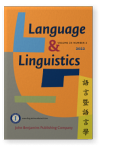Vol. 23:2 (2022) ► pp.329–348
Defective incorporating verbs in Mandarin
This paper identifies a type of noun incorporation in which the verb and a nominal are combined as early saturation of the verb, in contrast to early restriction, which is seen in the familiar type of noun incorporation. Two types of V-V resultative constructions in Mandarin Chinese are compared: the agent-oriented one and the patient-oriented one. The semantic grouping effects of the first verb and the post-verbal nominal of an agent-oriented type show that they are local to each other in their base-positions. But unlike in the patient-oriented one, the first verb in the construction shows a weak reachability. The defectiveness of the verb is parallel to that of an incorporated nominal in the familiar type of noun incorporation: e.g. no modification and no anaphoric linking to a proform. The paper argues that the first verb in the agent-oriented resultative construction and the post-verbal nominal, which can be a full-fledged referential nominal, undergo a type of noun incorporation parallel to the familiar type. In such noun incorporation, instead of the nominal, it is the verb that exhibits root-like properties. Such properties are viewed as a consequence of an early combination of a verb and a nominal, before each of them takes an event-argument, in a neo-Davisonian semantic perspective.
Article outline
- 1.Introduction
- 2.The semantic grouping of V1 and O in AR
- 3.The reachability differences of V1 in AR and PR
- 4.Root-like properties of V1 in AR and a new type of NI
- 5.A syntax of AR: Early merger of V1 with O
- 6.A semantics of AR: Early saturation of V1 by O
- 7.Conclusions
- Acknowledgments
- Notes
- Abbreviations
-
References
For any use beyond this license, please contact the publisher at [email protected].
